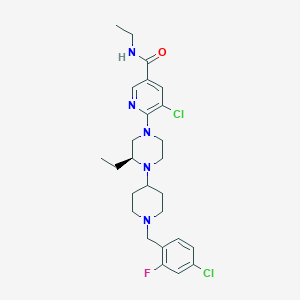

You can:
| Name | CHEMBL1681882 |
|---|---|
| Molecular formula | C26H34Cl2FN5O |
| IUPAC name | 5-chloro-6-[(3S)-4-[1-[(4-chloro-2-fluorophenyl)methyl]piperidin-4-yl]-3-ethylpiperazin-1-yl]-N-ethylpyridine-3-carboxamide |
| Molecular weight | 522.49 |
| Hydrogen bond acceptor | 6 |
| Hydrogen bond donor | 1 |
| XlogP | 5.2 |
| Synonyms | BDBM50337251 SCHEMBL13205646 (S)-5-chloro-6-(4-(1-(4-chloro-2-fluorobenzyl)piperidin-4-yl)-3-ethylpiperazin-1-yl)-N-ethylnicotinamide |
| Inchi Key | LXEUJQNDOXTGHH-NRFANRHFSA-N |
| Inchi ID | InChI=1S/C26H34Cl2FN5O/c1-3-21-17-33(25-23(28)13-19(15-31-25)26(35)30-4-2)11-12-34(21)22-7-9-32(10-8-22)16-18-5-6-20(27)14-24(18)29/h5-6,13-15,21-22H,3-4,7-12,16-17H2,1-2H3,(H,30,35)/t21-/m0/s1 |
| PubChem CID | 11569938 |
| ChEMBL | CHEMBL1681882 |
| IUPHAR | N/A |
| BindingDB | 50337251 |
| DrugBank | N/A |
Structure |  |
| Lipinski's druglikeness | This ligand is heavier than 500 daltons. This ligand has a partition coefficient log P greater than 5. |
You can:
| GLASS ID | Name | UniProt | Gene | Species | Length |
|---|---|---|---|---|---|
| 198669 | C-X-C chemokine receptor type 3 | P49682 | CXCR3 | Homo sapiens (Human) | 368 |
| 198670 | C-X-C chemokine receptor type 3 | Q9JII9 | Cxcr3 | Rattus norvegicus (Rat) | 367 |
| 198671 | C-X-C chemokine receptor type 3 | O88410 | Cxcr3 | Mus musculus (Mouse) | 367 |
zhanglab![]() zhanggroup.org | +65-6601-1241 | Computing 1, 13 Computing Drive, Singapore 117417
zhanggroup.org | +65-6601-1241 | Computing 1, 13 Computing Drive, Singapore 117417